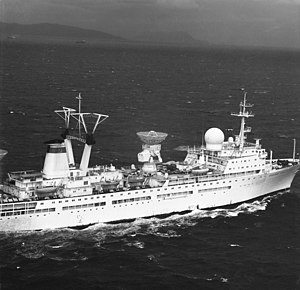Akademik_Sergei_Korolev
The Akademik Sergey Korolyov (Russian: Академик Сергей Королёв) was a space control-monitoring ship or Vigilship (Veladora) constructed in 1970 to support the Soviet space program. Named after Sergey Korolyov, the head Soviet rocket engineer and designer during the Space Race between the United States and the Soviet Union in the 1950s and 1960s, the ship also conducted upper atmosphere and outer space research.[1]
You can help expand this article with text translated from the corresponding article in Russian. (November 2019) Click [show] for important translation instructions.
|
In Soviet times, the Akademik Sergey Korolyov was a large communications ship which was part of a fleet of communications ships. These ships greatly extended the tracking range when the orbits of cosmonauts and unmanned missions were not within range of Soviet land-based tracking stations.[2] The ship mainly operated in the Atlantic Ocean monitoring spacecraft trajectory, telemetry data, and guaranteed a communications link with the cosmonauts.[3]
The ship had about 1200 accommodations, including 79 laboratories, in which 188 scientific workers performed their duties.[3]
In 1975, the ship was a part of the Soviet-American Apollo–Soyuz joint test program.[4]
The ship was also utilized in a joint US and Soviet research project studying links between the ocean and various atmospheric gasses.
Sold for scrapping and renamed OROL, arriving at Alang on 18 August 1996.
